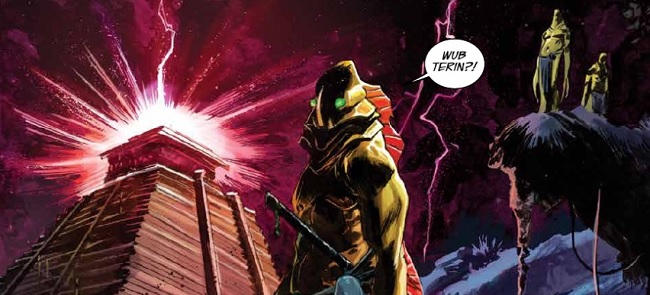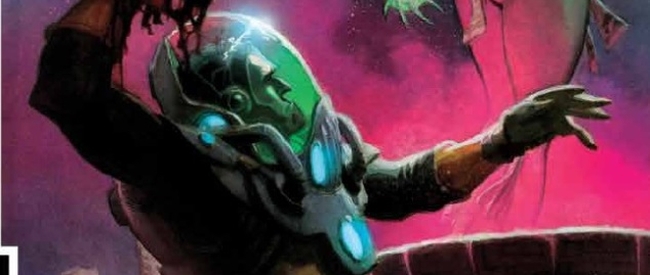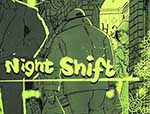Remender and Scalera cook up old school sci-fi with an anarchist twist and a side of psychedelia in Black Science.
Scientist Grant McKay and his Anarchist League of Scientists have broken through the walls of our universe and ventured into alien dimensions beyond. Utilizing the forbidden art of “black science,” McKay has gotten his team into a lot more than they bargained for, with murderous alien species and despotic frog-kings seemingly waiting for them at every turn. This is the world of Black Science, brought to you by writer Rick Remender, line artist Matteo Scalera, and painter Dean White. It’s perhaps best described as Lost in Space meets Sliders and, notwithstanding a few problems in establishing this comic’s backstory, it is very good.
Scalera and White’s artwork is spectacularly good at conveying the otherworldliness of the settings. There are a large number of two-page spreads in this book, but once you delve into the art, it’s easy to see why. Black Science has a strong cinematic streak in all of its aspects, and that’s only reinforced by the depth and perspective of the widescreen illustrations gracing every page.

Though Remender’s dialogue is, as always, sharp and to-the-point, and the action well-choreographed, there’s still something missing on the emotional end of things. When Grant McKay loses his wife Jen, the character’s pain just doesn’t translate across the page, doesn’t bridge the gap between the script and the reader. Partly this is due to another of the book’s flaws, namely that it is heavy on action and light on exposition. Most of this first issue is dedicated to McKay’s race against time to return to the team’s base with coolant for the Pillar, their interdimensional transport device. Without the coolant, the Pillar will explode, taking the rest of the team, among them Grant and Jen’s two children, with it.
For a later issue, this may be enough to carry the plot through a full twenty-eight pages. For a debut, however, with the reader still not fully invested in either the story or the characters, it’s hard to get off to a strong start with so little exposition. Backstory is inserted here and there in McKay’s internal monologue, and this usually works well, without coming across as too much of an infodump. The monologue itself, though, sometimes becomes tiresome, punctuating every page with McKay’s running commentary on the events of the story. When illuminating, his comments are welcome, but the majority of the captions could have been trimmed with only positive effects on the pacing.
The slightly muddled attempt at conveying the backstory is the only major flaw in Black Science, and this is a problem that may be easily corrected in the next few issues. This is a book with a strong sense of style and gorgeous artwork. It shows a lot of promise, and while the first issue may not meet all of your expectations, it definitely gives you good reason to come back for more.
Rick Remender (W), Matteo Scalera, Dean White (A) • Image Comics, $3.50, November 27, 2013















